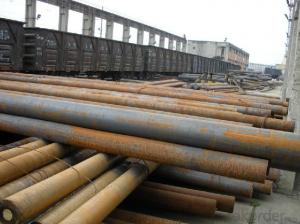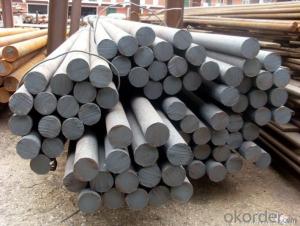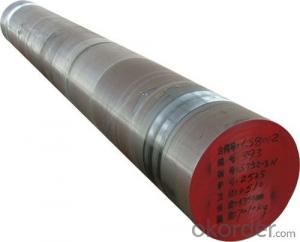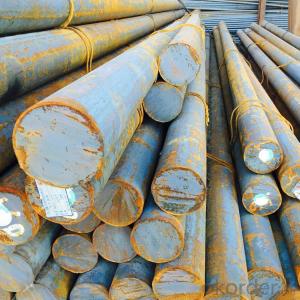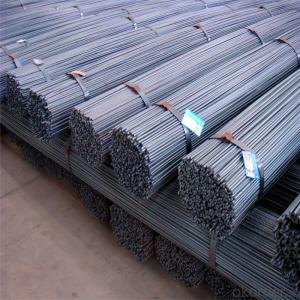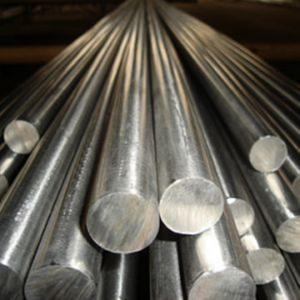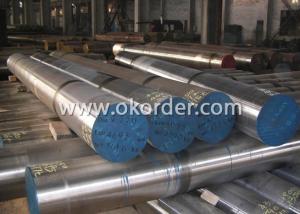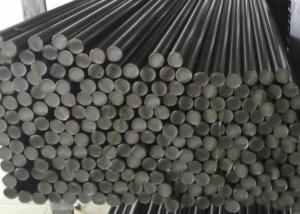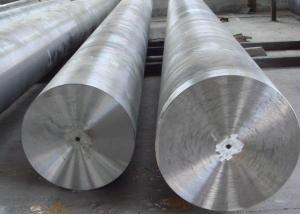20Cr Alloy Steel Bar Forged or Hot Rolled
- Loading Port:
- Tianjin
- Payment Terms:
- TT OR LC
- Min Order Qty:
- 25 m.t.
- Supply Capability:
- 50000 m.t./month
OKorder Service Pledge
OKorder Financial Service
You Might Also Like
Item specifice
20Cr Alloy Steel Bar Forged or Hot Rolled
Product Description:
Grade: ASTM 1020 / 20Cr
State:hot forging+normalizing+turning
Size:90mm to 1500mm
Length:4 to 6 meter or according to request
Billet:EAF+LF+VD
Straightness:≤4mm/m(black), ≤2mm/m(turning)
OD Tolerance:-0/+8mm(black),-0/+3 mm(turning)
Grain Fineness:ASTM E112-96 > Level 5 or better under annealing state;
Non Metallic Inclusion:ASTM E45 A/B/C/D heavy ≤2, thin ≤2.5
Test:SEP1921 CLASS C/C,D/d,E/e;GB/T 6402-91;GB/T6402-2008/ASTM A388/ASTM A709
MTC:EN 10204-3.1/EN10204-3.2 RONA/BV/SGS Certificate
Lead Time:30 to 60 days after order confirmed
Chemical composition:
Grade | C | Cr | Mn | Si | P | S | Ni | Cu | Mo |
≤ | |||||||||
20Cr | 0.18-0.24 | 0.70-1.00 | 0.50-0.80 | 0.17-0.37 | 0.035 | 0.035 | 0.30 | 0.30 | 0.15 |
Features and Use scope:
It has higer intensity and hardenability than 15Cr,worse toughness ,better weldability ,after welding it don't need to heat treatment.It used to making the parts which have special request in intensity of core and the larger-size appearance can bear abrasion ,or cementite parts of complex shape and seldom burthen ,such as gear , gear shaft ,cam, gudgeon pin ,worm and so on ,it also used to making tempering parts of big speed and can bear middle impact load.
Product Show:
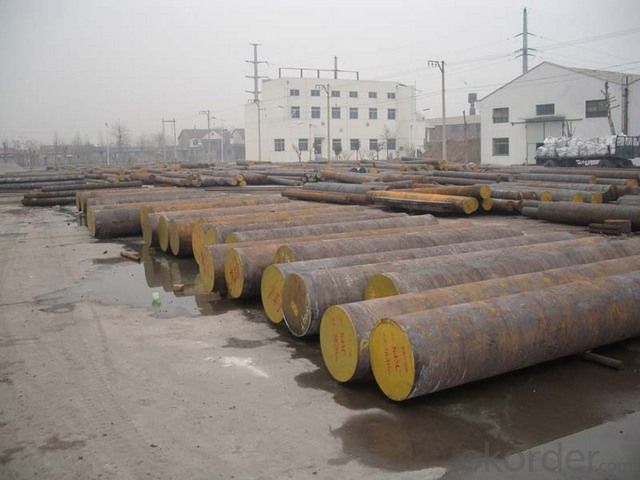

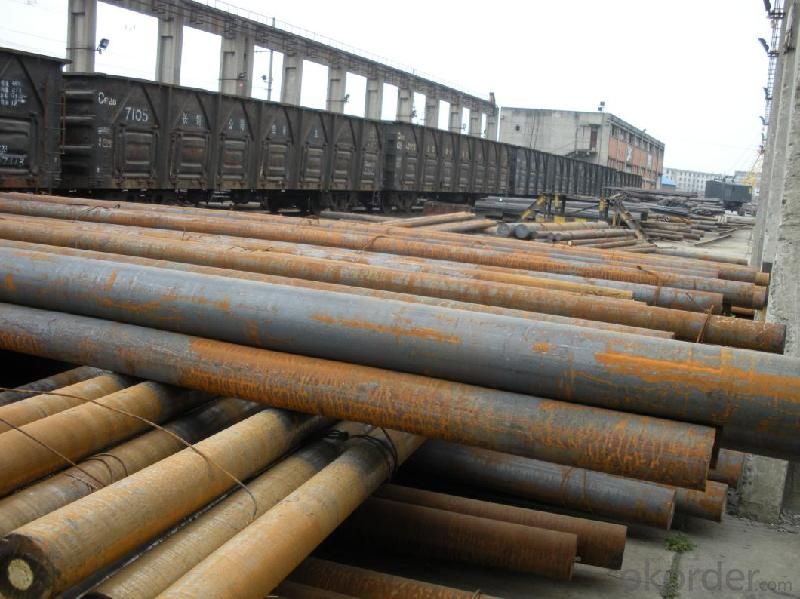
- Q:What are the different methods of surface pickling for special steel?
- There are several methods of surface pickling that can be used for special steel. These methods include: 1. Acid Pickling: This is the most common method used for pickling special steel. It involves immersing the steel in an acid solution, usually hydrochloric acid or sulfuric acid, to remove any surface impurities. The acid reacts with the oxide layer on the steel, dissolving it and leaving behind a clean surface. 2. Electrolytic Pickling: In this method, an electric current is passed through the steel while it is immersed in an electrolyte solution. This causes a chemical reaction that removes the surface impurities. Electrolytic pickling is a more controlled process and can be used to achieve a more uniform surface finish compared to acid pickling. 3. Mechanical Pickling: This method involves using mechanical means to remove the surface impurities from the steel. It can be done using abrasive materials, such as sandpaper or wire brushes, to physically scrub the surface and remove any scale or rust. Mechanical pickling is often used in combination with acid or electrolytic pickling to achieve the desired surface finish. 4. Passivation: After pickling, special steel can undergo passivation to enhance its corrosion resistance. Passivation involves treating the steel with a chemical solution, typically nitric acid or citric acid, to create a protective oxide layer on the surface. This layer helps to prevent further corrosion and improves the overall durability of the steel. It is important to note that the specific method of surface pickling used for special steel may vary depending on the type of steel, the desired surface finish, and the intended application. Therefore, it is crucial to consult with experts or follow the manufacturer's guidelines to ensure the appropriate method is used for pickling special steel.
- Q:How does the composition of special steel affect its mechanical properties?
- The composition of special steel significantly affects its mechanical properties. Various alloying elements such as carbon, manganese, chromium, nickel, and others are added in specific quantities to enhance the steel's strength, hardness, toughness, and corrosion resistance. The presence and ratio of these elements determine the steel's microstructure, which in turn determines its mechanical properties. For example, higher carbon content increases hardness and strength, while manganese improves toughness. Similarly, chromium and nickel increase corrosion resistance and provide better heat resistance. Therefore, the composition of special steel plays a crucial role in defining its mechanical properties.
- Q:What are the different methods of surface honing for special steel?
- There are several different methods of surface honing for special steel, each with its own advantages and applications. Some of the most commonly used methods include: 1. Manual Honing: This method involves using hand-held honing tools such as stones, sticks, or abrasive pads to manually remove material from the surface of the special steel. Manual honing allows for precise control and is often used for smaller or intricate parts. 2. Machine Honing: Machine honing utilizes specialized honing machines that automate the honing process. These machines typically consist of rotating honing stones or abrasive belts that remove material from the surface of the steel. Machine honing is often preferred for larger or more complex parts, as it can achieve consistent and high-quality results. 3. Diamond Honing: Diamond honing is a method that uses diamond abrasives to remove material from the surface of the special steel. Diamond is one of the hardest substances known, making it highly effective for honing steel. This method is often used for high-precision applications or when a very smooth surface finish is required. 4. Superfinishing: Superfinishing is a specialized honing process that is used to achieve extremely fine surface finishes on special steel. It involves using a combination of honing stones and abrasive pastes to remove microscopically small amounts of material from the surface. Superfinishing is typically used for critical applications where surface roughness and dimensional accuracy are of utmost importance. 5. Lapping: Lapping is a honing method that uses a combination of abrasive particles and a rotating or vibrating tool to remove material from the surface of the steel. It is often used for parts that require a very flat or parallel surface, such as bearings or sealing surfaces. 6. Electrochemical Honing: Electrochemical honing is a specialized honing process that uses an electric current to remove material from the surface of the special steel. It is often used for complex or hard-to-reach surfaces, as it can effectively remove material from areas that are difficult to access with other honing methods. In summary, the different methods of surface honing for special steel include manual honing, machine honing, diamond honing, superfinishing, lapping, and electrochemical honing. Each method has its own unique advantages and applications, allowing for precise control and achieving the desired surface finish and dimensional accuracy for special steel components.
- Q:How does the cost of special steel compare to regular steel?
- The cost of special steel is generally higher than regular steel due to its unique properties, manufacturing processes, and limited availability.
- Q:What are the main characteristics of magnetic steel forgings?
- Magnetic steel forgings exhibit several key characteristics that make them highly desirable in various industries. Firstly, magnetic steel forgings possess excellent magnetic properties, allowing them to be easily magnetized and demagnetized. This property makes them suitable for applications where magnetism is required, such as in electrical motors and generators. Secondly, magnetic steel forgings possess high strength and durability. Due to the forging process, the steel is compressed and shaped, resulting in a dense and uniform microstructure. This enhances the mechanical properties of the steel, including its tensile strength, impact resistance, and fatigue strength. As a result, magnetic steel forgings can withstand heavy loads and harsh operating conditions, making them ideal for use in demanding applications such as automotive components, industrial machinery, and aerospace parts. Another characteristic of magnetic steel forgings is their excellent corrosion resistance. The forging process helps to refine the grain structure of the steel, making it less susceptible to corrosion and oxidation. This property is crucial in industries where components are exposed to corrosive environments or high temperatures, such as marine applications or oil and gas equipment. Furthermore, magnetic steel forgings offer good machinability and weldability. The forging process not only enhances the mechanical properties of the steel but also improves its machinability, allowing it to be easily shaped and modified into intricate designs. Additionally, magnetic steel forgings can be readily welded without compromising their integrity, providing flexibility in manufacturing and assembly processes. Lastly, magnetic steel forgings exhibit excellent dimensional stability. The forging process involves controlled heating and cooling, which helps to minimize dimensional changes and distortions. This ensures that the final product maintains its shape and dimensions, enabling precise fit and compatibility with other components. In summary, the main characteristics of magnetic steel forgings include excellent magnetic properties, high strength and durability, corrosion resistance, good machinability and weldability, and dimensional stability. These characteristics make magnetic steel forgings highly versatile and widely used in various industries, contributing to their overall success and popularity.
- Q:What are the different machining techniques used for special steel?
- Some of the different machining techniques used for special steel include turning, milling, drilling, grinding, and honing. These techniques are used to shape and finish the special steel according to specific requirements and tolerances. Each technique has its own advantages and is chosen based on factors such as the type of special steel, desired dimensions, surface finish, and the complexity of the part being machined.
- Q:What are the different surface treatments applied to special steel?
- Enhancing the properties and improving the performance of special steel can be achieved through the application of different surface treatments. Commonly used treatments include: 1. Utilizing heat treatment involves subjecting the steel to specific temperatures and controlling the cooling process. This treatment enhances the steel's hardness, strength, toughness, wear resistance, and corrosion resistance. 2. Coating the surface of special steel with a protective layer is another frequently used surface treatment. Electroplating, hot-dip galvanizing, and powder coating are some methods employed. Coatings provide added corrosion resistance, enhance the appearance of the steel, and prolong its lifespan. 3. Nitriding is a process that diffuses nitrogen into the steel's surface at high temperatures. This forms a tough outer layer, improving wear resistance and fatigue strength while maintaining core toughness. 4. Shot peening is a mechanical treatment that involves bombarding the steel surface with small spherical particles made of steel or ceramic. This induces compressive stresses in the surface layer, improving fatigue strength and resistance to stress corrosion cracking. 5. Passivation is a chemical treatment used to eliminate impurities and contaminants from the steel's surface, typically by immersing it in an acid solution. This process restores the natural corrosion resistance of stainless steel by forming a protective oxide layer. 6. Electro-polishing is an electrochemical process that removes a thin layer of material from the steel's surface. It improves surface finish, eliminates micro-roughness, and enhances corrosion resistance. These are just a few examples of the various surface treatments applicable to special steel. The choice of treatment depends on the specific requirements of the application and the desired properties of the steel.
- Q:How does special steel perform in forging applications?
- Special steel is highly desirable for forging applications due to its exceptional strength, durability, and resistance to wear and tear. It offers superior performance as it can withstand the intense heat and pressure involved in the forging process without losing its shape or integrity. Additionally, special steel's unique composition allows for precise shaping and intricate designs, making it an ideal choice for complex forging projects.
- Q:What are the different surface coating methods used for special steel?
- Special steel can be enhanced and protected from environmental factors using various surface coating methods. These methods include: 1. Galvanizing: Zinc is applied to the steel surface, offering exceptional corrosion resistance. This can be achieved through hot-dip galvanizing or electroplating. 2. Electroplating: A thin layer of metals like chromium, nickel, or copper is deposited onto the steel surface using an electrochemical process. This improves appearance, wear resistance, and corrosion resistance. 3. Powder coating: Dry powder is applied to the steel surface, heated, and fused to create a protective layer. This provides durability, weather resistance, and aesthetic appeal. 4. Thermal spray coating: A heated or molten material is sprayed onto the steel surface, solidifying into a protective coating. Materials like metals, ceramics, and polymers are commonly used. 5. Paint coating: Painting is a widely used method for surface coating. Epoxy, polyurethane, or acrylic paints can be applied to protect against corrosion, chemicals, and UV radiation. 6. PVD coating: A thin film of materials like titanium nitride or diamond-like carbon is deposited onto the steel surface through vacuum deposition. PVD coatings enhance hardness, wear resistance, and appearance. 7. Anodizing: Primarily used for aluminum, anodizing can also be applied to special steel. It involves creating an oxide layer through an electrochemical reaction, improving corrosion resistance and providing a decorative finish. These surface coating methods are crucial for special steel as they enhance protection against corrosion, wear, and environmental factors. This ultimately extends the steel's lifespan and improves its performance. The choice of coating method depends on the specific requirements and desired properties of the steel.
- Q:How is special steel graded?
- Different factors, including its chemical composition, mechanical properties, and intended application, are taken into account when grading special steel. The grading system provides a standardized classification that aids in the identification and selection of the appropriate steel type for specific purposes. One commonly used method of grading special steel involves the use of alphanumeric codes. These codes consist of a combination of letters and numbers that represent specific characteristics of the steel. For instance, the American Iron and Steel Institute (AISI) employs a four-digit numbering system to grade various steel alloys. The first digit signifies the main alloying element, such as carbon or manganese, while the subsequent digits provide additional information regarding the steel's composition and properties. In addition to alphanumeric codes, special steel can also be graded based on its mechanical properties. This entails testing the steel's strength, hardness, toughness, and other performance indicators. The results of these tests determine the steel's specific grade, which helps users assess its suitability for particular applications. International standards organizations like ASTM International and the International Organization for Standardization (ISO) provide guidelines and specifications for grading special steel based on these mechanical properties. Furthermore, the intended application of the special steel also significantly influences its grading. Industries such as aerospace or automotive have specific material requirements. Therefore, special steel intended for these sectors is graded based on its ability to meet those requirements, such as corrosion resistance, heat resistance, or wear resistance. Special steel grades can also be categorized based on their ability to withstand extreme conditions or fulfill specific functions, such as tool steels for cutting or forming operations. Overall, the grading of special steel involves considering its chemical composition, mechanical properties, and intended application. By utilizing standardized grading systems and specifications, manufacturers, engineers, and other users can easily identify and select the most suitable type of special steel for their specific needs.
1. Manufacturer Overview |
|
|---|---|
| Location | |
| Year Established | |
| Annual Output Value | |
| Main Markets | |
| Company Certifications | |
2. Manufacturer Certificates |
|
|---|---|
| a) Certification Name | |
| Range | |
| Reference | |
| Validity Period | |
3. Manufacturer Capability |
|
|---|---|
| a)Trade Capacity | |
| Nearest Port | |
| Export Percentage | |
| No.of Employees in Trade Department | |
| Language Spoken: | |
| b)Factory Information | |
| Factory Size: | |
| No. of Production Lines | |
| Contract Manufacturing | |
| Product Price Range | |
Send your message to us
20Cr Alloy Steel Bar Forged or Hot Rolled
- Loading Port:
- Tianjin
- Payment Terms:
- TT OR LC
- Min Order Qty:
- 25 m.t.
- Supply Capability:
- 50000 m.t./month
OKorder Service Pledge
OKorder Financial Service
Similar products
New products
Hot products
Hot Searches
Related keywords
